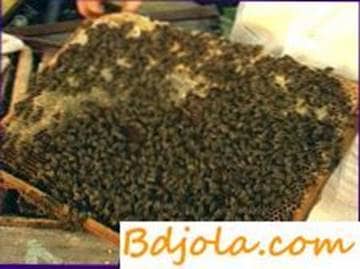
Bees, depending on their breed, when examining the nest react differently. Southern bees are very peaceful. Nests can be examined without a facial mesh, and sometimes even without smoke. Central Russian bees are covetous, and when inspecting the nest, a smoke is needed.
Bees do not know the master and in their behavior obey instinct. Therefore, the peacefulness of bees largely depends on the accuracy and ability to handle them themselves beekeepers.
Before examining the nest of bees, you must first look through the passe magazine. This will identify families in which you must first carry out certain work and prepare the required material for work, equipment and equipment.
In greenhouses it is more convenient to inspect bees in the morning, and in rainy and cloudy weather – throughout the day.
Bee families with increased malice, as well as bezmatychnye inspect last.
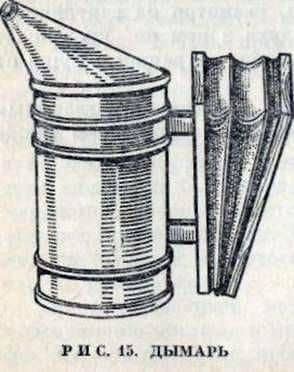
For inspection of bees, a smoke is kindled. For this it is enough to put a lit match in a cylinder with combustible material. At the beginning of the work, so that the smoke does not go out, it is placed vertically, and the thrust is increased. The flared up smoke is placed on the side to reduce the burning. At the end of the work, the smoke cover is slightly opened, and the lower and upper ones: the holes are closed – the smoke fades. For the purpose of fire safety, the smoke is ignited and stored separately from flammable materials under a canopy.
Flammable material for the smoke can serve dry rotten trees of soft breeds or mushroom tinderboxes growing on rotten trees. It is impossible to use rotten trees of hard trees. Their hot smoke burns and excites the bees. Units of conifers are undesirable, especially if they are raw, since they excrete tarry substances that stain the frame.
Bees will be more relaxed, if in a smoke to burn the rejected frames or old canvases. At this it is necessary to make sure that the bee corpses do not get into the smoke with the bars and the canvas, since their smell causes a strong irritability of the bees in the family under examination.
The clothes of the beekeeper have a great influence on the behavior of the bees during their inspection. It should not be fluffy and have extraneous smells. Even a freshly washed dressing gown has a scent of soap, irritating bees. Before you dress, it needs to be well ventilated.
It is better to work in a white coat, it is not hot and less bees sits on it. The sleeves of the robe and the pants at the bottom should be on elastic bands and fit snugly to the body.
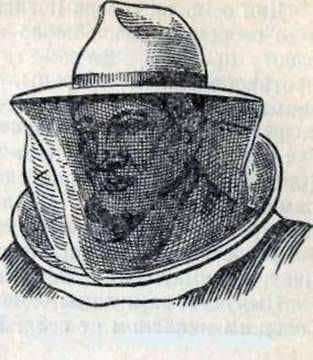
Fig. 16. Facial mesh
Regardless of whether you have to use the facial mesh or not, it should always cover the head. In order not to feel afraid to be stung, the beginning beekeeper should wear a facial mesh. The work will be more peaceful and successful. There is nothing reprehensible if you wear clean rubber or dense gloves on your hands. Over time, skills and confidence in work will be developed, the beekeeper will forget that he works without a facial mesh and gloves. Accidental stinging of bees will be taken for granted, and the body’s reaction becomes invisible.
Before opening the hive, 2-3 streams of smoke are sent to the duct. After this, it takes 1-2 minutes to wait until the bees fill their zobics with honey, their abdomen becomes full, not flexible, making it difficult to sting, and the bees themselves are peaceful.
To inspect the nest, the beekeeper becomes from the side of the hive that is convenient for him, usually on the side of the diaphragm. If the work is carried out together, the assistant is located on the opposite side. Carefully, without shaking remove the lid and put it behind the hive. Unbending the angle of the canvas or removing the ceiling plates on 2-4 frames, immediately on top of them start up 1-2 smoke streams.
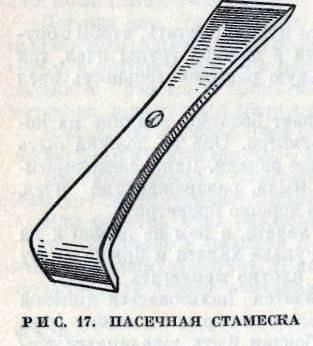
A chamfer on both sides is moved from the place of the diaphragm and the frame. Then they are set aside to the wall of the hive. Free space allows you to gently, obliquely, so that the edge of the frame does not press down the uterus or bees to the hive wall, take out honeycombs for inspection.
The drawn frame is viewed vertically with a slight inclination from itself. If the frame is held flat,
It can bend, it will drip nectar and pollen. The inspected frame, so as not to drop the uterus and non-flying bees, is held over the hive. After examining one side of the coot, the frame turns and looks at the other side.
If you want to remove from the hive malomedny honeycomb, it is taken with your left hand over the shoulders, lowered to the bottom of the hive and the fist of the right hand hit the side lath 1-2 times. Frames with brood, especially with queen cells, can not be shaken off, the bees are swept away with a soft brush or a bunch of grass. To avoid breaking the honeycombs, do not shake the bees with jerks from the full copper bars.
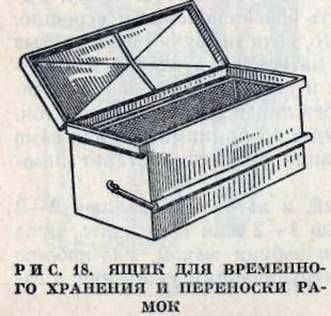
The seized frames are placed in a closed portable box. A great difficulty in examining nests is when the nest is filled with frames. In this case, for convenience, it is necessary to remove frames from the socket for the time of operation. It is most difficult to remove the first frame from the socket. To do this, the streets of the neighboring frames are slightly narrowed, increasing the space near the extracted frame. These processes are spent some time, which is especially undesirable in the autumnless period. Taking this into account, it is advisable to put only 11 frames and a diaphragm into 12-frame beehives, and if necessary expand the nest – 1-2 magazine extensions.
If you need to find out if there is a uterus in the hive, then there is no need to look for it – the presence of eggs indicates its presence. If it is required to find the uterus, then it is searched on the framework where the eggs are laid. You can not abuse smoke because the uterus can move to another frame, the wall of the hive or to the bottom.
Work with bees quickly, but without fuss and haste. In this regard, beekeepers have a saying – hurry, but slowly. Bees do not like sharp movements and waving, and also a smell of spirits, cologne, gasoline, kerosene, garlic, dried blood, sweaty clothes, etc. After finishing the examination of the nest, the frames are put in their original place. In hothouse bee families, to speed up the work, the nest can be left in the opposite part of the hive, and the next time it is examined, it is moved to its original place.
When examining the nest of bees, one must be especially careful in working with frames that have dividers. You can not move one frame to the other, because the bees will be choking. The frame is lifted up and put it in the socket from above so that the dividers slide one over the other and the bees do not hit between them. Bees react strongly to the smell of their own poison. A crushed or stung bee serves as a signal to protect the home. No matter how malicious the bees are, work must be completed, in any case, not to throw an open beehive.
If you are stung by a bee, it is better to kill it, otherwise it will interfere with work and excite other bees.
The stinger is removed by pressing and sliding over the Fingertip with the finger nail. Sting can not be removed with two fingers, in this case, the poison remaining in the sting is injected into the body. To prevent the tumor, the poison is immediately squeezed out or suctioned from the wound, and a stung spot is fumigated with several smoke streams to muffle the spread of the odor. All this is done quickly, quietly, without interrupting the work being done.
In a break between examinations of bee colonies, stung hands should be washed. If the hands are heavily soiled, propolis is easily washed with dilute ammonia in water. Then dry hands rub one of the herbs: melissa, cats, mint or anise.
Because of the absence of wind and other adverse events, bees in greenhouses are less evil than are free. However, when working in a greenhouse for the formation of plants, the removal of leaves and harvesting can be the accidental ablation of workers. In individuals with hypersensitivity to bee venom, stinging in the hand can cause a whole-body swelling, the appearance of a nettle rash, an increase in body temperature, dyspnea, nausea, dizziness and laryngeal edema on the body, which in extreme cases can lead to death.
To provide first aid to the victim give a tablet of diphenhydramine, and in his absence resort to a folk remedy: give vodka with honey. In severe cases, call a doctor who injects adrenaline (1: 1000), and with a fall in cardiac activity – caffeine and camphor.
Медовик на сметане. Перевозка пчел.
Hothouse beekeeping